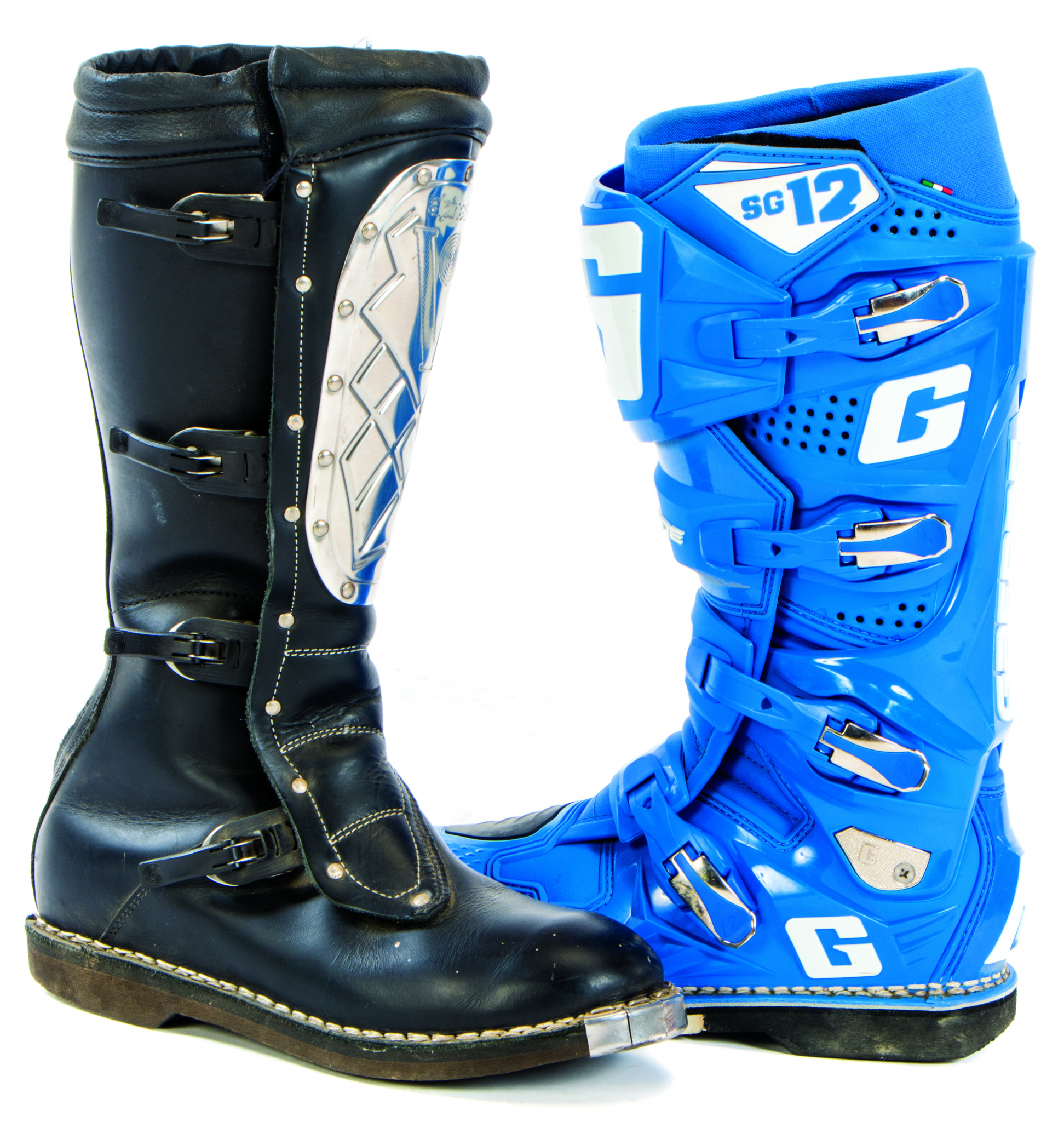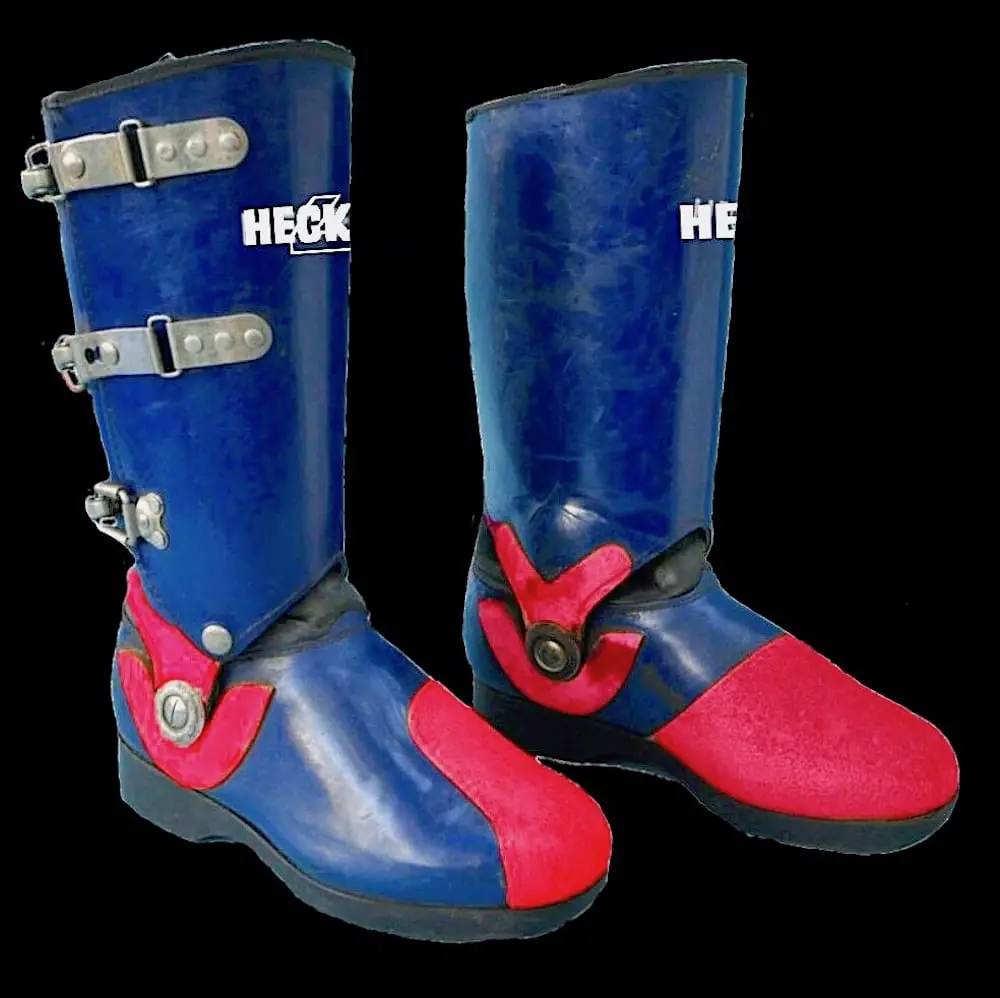TEN THINGS ABOUT MOTOCROSS BOOT PHILOSOPHY
 (1) Goal. Each motocross boot brand makes high-end boots for racing and more affordable boots for entry-level riding. Boot companies strive to protect the rider’s foot, ankle and leg from harm while still allowing the rider to grip the motorcycle in a way that is natural and confidence-inspiring.
(1) Goal. Each motocross boot brand makes high-end boots for racing and more affordable boots for entry-level riding. Boot companies strive to protect the rider’s foot, ankle and leg from harm while still allowing the rider to grip the motorcycle in a way that is natural and confidence-inspiring.
(2) History. Back in the day boots were made primarily out of leather. They were lightweight, flexible and comfortable. The 1974 Heckel boots were the first-ever, plastic, hinged, motocross boots; however, they didn’t last long on the sales charts because the toe box, sole and footbed offered no feel for the footpeg, shifter or brake pedal. They were also much heavier than leather boots at 4.3 pounds. Funny enough, that concept and weight is actually standard for today’s boots.
(3) Preferences. When it comes to boots, some of MXA’s test riders are pickier than others. We have die-hard Gaerne SG-12 guys, die-hard Sidi guys, die-hard Alpinestars Tech 10 guys and, of course, Jody is a die-hard Alpinestars Victory boot guy. He appreciates the modern advancements of motorcycle technology, but he still chooses to wear the same-style leather boots today that he wore back in the 1970s.
(4) Contrast. Boot manufacturers are constantly searching for the right balance between cool and safe, flexible and protective, and exciting tech and light weight. If they add on innovative features, their salesmen have more selling points to tout. But, more often than not, added tech means added weight and rigidity. The hard part is that each rider is different and his preferences differ as well.
(5) Soft boots. Soft-boot apologists say that they can feel the motorcycle better with boots that are more pliable. With soft boots, it’s easier to position your feet on the pegs properly. You can point your toes in and ride on the balls of your feet with less effort. Plus, it’s easier to be more precise when applying the rear brake and shifting. Softer boots also allow riders to feel the track easier. One downfall, however, is that softer boots provide less protection for harsh impacts.
(6) Stiff boots. The benefit of stiffer boots is the added strength around your heel, ankles and lower legs. Stronger boots protect more on impact, and they can act as an extra set of suspension, too. Long days of riding are made easier when your boots help absorb the impacts of bumps and jumps. Plus, stiffer boots usually have increased durability, which means your dollar goes further. Stiff boots make it more difficult to feel the footpeg and easier to be clumsy when shifting or using the rear brake, which can be dangerous. Stiffer boots also tend to be bigger, which makes it easier to catch your toe and twist your ankle in ruts.
(7) Hinges. Performance-level boots use hinges to increase flexibility, lessen break-in time and increase durability. Hinges allow companies to use strong material while still getting the boot to flex. Nowadays, the only boots without hinges are the lower price-point boots with softer leather and softer plastic compounds. These break in easily but also offer less protection for serious riders.
(8) Flex stoppers. With the addition of hinges also came flex stoppers, which are little shelves integrated into the top-tier boots to limit the ankle’s range of motion and prevent injury. The Alpinestars Tech 10 boot also features a frontal flex-control system that works like suspension for your ankle as it bends forward. Originally, these were made too stiff, and riders had to cut them by hand to get the boots to flex. Now, Alpinestars has fixed the issue.
(9) “Big Three.” Some of the biggest and stiffest boots on the market are the Alpinestars Tech 10s, and some of the softest and most pliable boots are the Sidi Atojo and Sidi Crossfire 3 boots. The Gaerne SG-12s fall in the middle. SG-12s are slimmer than Tech 10s and bigger than Sidi boots. After break-in, they flex easier than Tech 10s but not as easily as Sidis. The common denominator between these three boot brands is their Italian design departments.
(10) Decision. There’s no universal right or wrong when it comes to boot philosophy. Everyone has their own opinions. Choosing the right boot comes down to due diligence on your part. Try on a lot of boots before buying; otherwise, you’ll be forced to stick your foot into something that you don’t like.








Comments are closed.